IAC News
IAC News No.52, February 2017
Japan Society of Civil Engineers International Activities Center February 1, 2017 IAC News No.52
Interview to Dr. K. Horikoshi, Secretary-General of ACECC

Dr. Kenichi Horikoshi
Secretary-General, ACECC
Asian Civil Engineering Coordinating Council (ACECC) was established by JSCE (Japan), ASCE (USA), PICE (Philippines), CICHE (Taiwan) and KSCE (Korea) in 1999. This united organization is expceted to solve problems on development and maintenance of infrastructures and civil engineering in the Asian region by discussions among member countries. ACECC offers the place of that discussions by holding Civil Engineering Conference in Asian Region (CECAR) continuously. That is one of the motif of establishing ACECC. The present member is 13 bodies consisted of five bodies relating to the establishment and additional bodies, IE Australia (EA at present, Australia), VFCEA (Vietnam), IEP (Pakistan), MACE (Mongol), HAKI (Indonesia), ICEI (India), IEB (Bangladesh) and NEA (Nepal). CECAR is held once every 3 years. 7th CECAR (CECAR7) is the latest that held in Hawaii, USA in August 2016.
Organization chart of ACECC is shown in Fig. 1. Executive Committee Meeting (ECM) is the highest body of this union and held twice every year. Financial Committee Meeting(FCM), Technical Committee Meeting(TCCM), Planning Committee Meeting (PCM) and local organizing committee for CECAR (LOC) are organized under the ECM. TCCM manages Technical Committees (TCs) that are set up for solving technical problems and whose main members are from ACECC member organizations. A current Secretary - General of ACECC is Dr. Kenichi Horikoshi (Taisei corporation, Japan) and a standing secretariat is also located in Japan today. Japan plays a role like a leader in ACECC and works in TC actively.
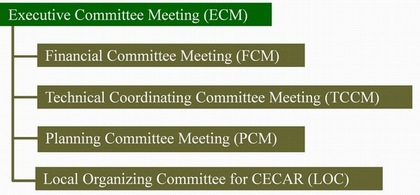
Fig.1 ACECC is managed by ECM and other committees’ meetings.
CECAR8, the next one, is held in Japan 2019. Therefore, Japan is expected to further act and contribute for solving problems in Asian region. CECAR 8 is coming in about 2 years. However, activities of ACECC are not known enough. So, IAC editors team interviewed the ACECC Secretary-General, Dr. Kenichi Horikoshi about activities of ACECC.
Q1: One of the purposes of ACECC is holding CECAR once every 3years. What is the other activities of ACECC? Please tell us about concrete activities. If there is a special activity to which ACECC gives high priority at present, also tell it please.
Our activities besides CECAR include: 1) Technical Committee, 2) Communication among engineers from industry, academia, and government of ACECC member economies, 3) Presentation of ACECC Awards, and 4) Communication among young engineers. I would like to explain the details of these activities as follows.
1) Technical Committee: TC
As ACECC is an organization based on the technological collaboration of academic societies/institutions, TC plays an important role. In 2001, JSCE mainly launched the first two TCs: “TC1:Asian and Pacific Coastal Network (Chair:Prof. Wataru Kioka)” and “TC2:Integrated River Management (Chair:Prof. Kengo Sunada).” Since then, 21 TCs have been organized in total with some of them already terminated and JSCE has hosted 9 TCs. In 2016 Japan has become a host country for ACECC with the term of office for 3 years, we try to activate TC activities. Also in 2016, JSCE proposed and launched “TC21:Transdisciplinary Approach for Building Societal Resilience to Disasters (Chair:Prof. Kuniyoshi Takeuchi).” As disasters are common and the most concerned theme in the Asian region, we would like to contribute to the region with Japanese expertise and experiences and strengthen ACECC’s presence. I believe this will activate TC activities by ACECC member economies more.
2) Communication among engineers from industry, academia, and government of ACECC member economies
One of the major purposes of CECAR, which will be held on triennial basis, is to exchange and discuss about civil engineering ideas and information among engineers from industry, academia, and government who are involved in infrastructure development. This is totally different from usual academic international conferences. In addition to CECAR, at the time of an Executive Committee Meeting which will be held twice a year, we hold seminars and symposiums as many as possible to deepen exchange with engineers of ACECC member economies.
3) Presentation of ACECC Awards
We have established 2 awards; ACECC Civil Engineering Project Award and ACECC Civil Engineering Achievement Award and give awards at CECAR. The Project Award will be granted to the outstanding project which has contributed to the advancement of civil engineering technology and development in Asia in the past 3 years, in principle. And for the most distinguished project, ACECC Outstanding Civil Engineering Project Award will be granted. The Achievement Award will be granted to a person belonging to a member society of ACECC who has made a significant contribution to the advancement of international civil engineering or to the development of social infrastructure in Asia or in ACECC member economies, and who has gained recognition for that contribution from the community for which he/she worked. All the projects and persons nominated by JSCE were granted both awards. Still ACECC Awards are relatively unknown. We have to advertise more to add its value.
4) Cultivation of young generation and communication among young engineers
After Japan assumed the chairmanship, we have put great effort into this new activity. Nearly 20 years have passed since ACECC was established, generation change is needed in the main members. So we have launched “Future Leader Forum” by young generation who would carry vital role in the future of infrastructure development in Asia. We plan to make them to attend an ECM of ACECC and the related events to build their network. In addition, we encourage the participation of many students in CECAR.
Q2: ACECC are administrated by as many as 13 countries. What is a role of Japan among them? Please tell us about roles for Japanese in ACCEC.
When ACECC was established in 1999, the number of members is 5 economies including Japan, the Philippines, the U.S., Korea, and Taiwan. From the beginning, JSCE has greatly contributed to the establishment of the basic principles, institutionalization and the management. Whenever I talk with Asian engineers, I feel their strong interest and expectations towards Japanese civil engineering technology. In particular, Japan has worked on fields like disaster prevention, environment, transportation, and city for a long time and has many top-class engineers in industry, academia and government. These are the fields we can provide Japanese great technical expertise and experiences to contribute to the world.
Q3:We suppose that it is not easy for Japan to lead ACECC activities because each member has each intension of joining to ACECC. Moreover, posture on activities, economic magnitude, religion and culture are also different among members. Therefore, we suppose that there were some problems in the activity. What was the solution for the problem? If there were hardships on ACECC activities, please tell us about that.
At the time of 2016, the number of ACECC member societies/institutions extends over 13 economies. As the economic level and the infrastructure developments differ, the challenge from the start of ACECC has been how to deal with diversity unique to Asia. The annual membership dues have 6 categories based on GNI reported by World Bank in order to reflect each economy’s economic level, ranging from US$200 to 2,500. So there is a big difference among the dues depending on the economic level, with more than 10 times the difference. In some cases, as the economic level has increased rapidly, the category of the annual membership dues goes up in a short period accordingly.
Regarding the ECM and international conferences hosted by ACECC, we give extra consideration to the venue and the accommodation level to reduce economic burden and provide financial support by setting a rule. In particular, in the CECAR8 which will be held in Tokyo in 2019, we would like to give consideration to the participation fee, accommodation, and the schedule so that every economy which is interested in improvement and development of infrastructure can afford to participate.
In addition, for mutual visits by ACECC member economy, when a visa is difficult to get because of strict visa requirements, ACECC Secretariat try hard to support so that ACECC members will not face with a difficulty in participating ACECC events.
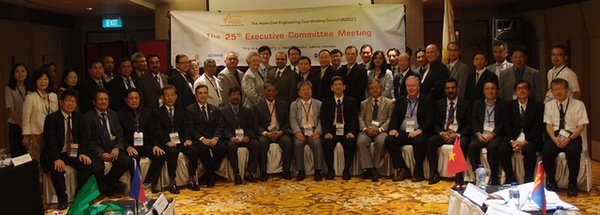
ACECC Executive Committee Meeting (25th ECM, Jakarta, August 2013)
Q4: CECAR 8 is held in Japan 2019. Please tell us what you expect to that.
The Civil Engineering Conference in the Asian Region (CECAR) is the largest-scale conference in that region which will be held on triennial basis. It will be the second time to be held in Japan after 18 years since it was held in Tokyo in 2001. As the year 2019 is one year before the Tokyo Olympics, it will be a good opportunity to introduce the construction progress of Olympic related facilities and infrastructure development as well as to appeal recovery from damage due to the Great East Japan Earthquake occurred 8 years ago. Also in 2019 ACECC will celebrate its 20th anniversary of foundation, reach a major milestone for the future.
Different from other international conferences, in CECAR, leaders from industry, academia, and government who engage in infrastructure development get together and discuss the future of infrastructure in Asia. While each academic society/institution undertakes the responsibility for international conferences regarding individual academic field, in CECAR, the latest technology, knowledge, and experiences are discussed in a cross-sectional way by the specialists from industry, academia, and government.
CECAR also provides an important opportunity to gather all presidents of ACECC member economies (13 economies at present) and send a message agreed toward the world. I’m sure this will enhance the appeal of joining ACECC and lead to increase membership more and more.

Leaflet for introducing CECAR8 (distributed at CECAR7 in Hawaii 2016)
Participation Report on the 7th CECAR
From August 31 to September 2, 2016, the 7th Civil Engineering Conference in the Asian Region (CECAR 7) was held by the Asian Civil Engineering Coordinating Council (ACECC) in Honolulu, Hawaii, USA. The ACECC was launched in September 1999 as a coalition organization to coordinate civil engineering-related academic societies and associations in the Asian region. The ACECC, presently having 13 member organizations, plays a key role in discussing and solving problems relating to the improvement of infrastructure and civil engineering technologies in the Asian region.
The CECAR is an international conference held every three years, where leading members of industry, government and academia, including presidents of academic societies and associations, gather together. CECAR 7, the seventh conference, was held under the auspices of the American Society of Civil Engineers (ASCE) with 388 participants from 29 countries.
CECAR 7 opened with speeches by Mr. Udai P. Singh, Chair of the Conference Steering Committee, and by Ms. Tulsi Gabbard, U.S. Congresswoman. Next, Dr. Ishii Yumio, vice president of the World Federation of Engineering Organizations (WFEO) and a former president of the Japan Society of Civil Engineers, gave a talk on the Kyoto Statement adopted at the 5th World Engineering Conference and Convention (WECC2015). (Photo 1)

Photo 1: Opening ceremony
Six programs were presented by guest speakers from the ACECC. Professor Isobe Masahiko from Japan, who is the president of Kochi University of Technology and a former president of the Japan Society of Civil Engineers, delivered a talk under the title of "2011 Great East Japan Earthquake Tsunami and Future Nankai Trough Earthquake Tsunami – Experience and Preparation."
In the organized session planned and operated by academic societies and associations belonging to the ACECC, the Member Society and Technical Committee (TC) of the Japan Society of Civil Engineers was assigned to handle the tsunami session, in which Prof. Takahashi Tomoyuki from Kansai University played a central role in raising the profile of Japan’s advanced technologies for tsunami disaster prevention.
In the general lectures, 220 research presentations were given in the form of poster sessions and speeches at six sites. Of these, 84 were presented by Japanese participants, the largest number of presentations among the participating countries. In addition, the results of TC activities led by the Japan Society of Civil Engineers were reported in programs such as special sessions.
The ACECC has established the ACECC Civil Engineering Project Award and ACECC Civil Engineering Achievement Award, and holds an award ceremony at the CECARs. The ACECC Civil Engineering Project Award is presented to a project that has made a remarkable contribution to the progress of civil engineering and the development of Asia during the last three years or so. This time, "Construction of the Yamate Tunnel on the Central Circular Route” by Metropolitan Expressway Company Limited (aka Shutoko) and four other projects nominated by other countries received the prize. Meanwhile, the ACECC Civil Engineering Achievement Award is presented to an individual who has made a remarkable contribution to the progress of international civil engineering and the social capital development of Asian countries or ACECC member countries. Dr. Sumiyoshi Yukihiko (advisor to the Japan Bridge Bearing Association and former director-general of the Public Works Research Institute) nominated by the Japan Society of Civil Engineers and three other persons received the prize (Photo 2).
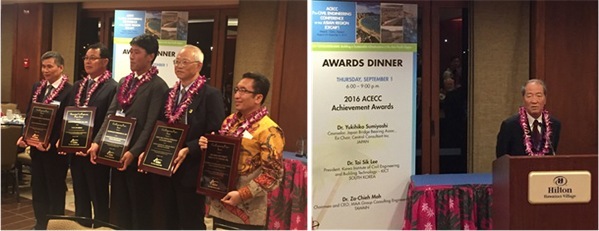
Photo 2: Presentation of ACECC awards
(middle in left photo: Mr. Namikawa from Shutoko, right: Dr. Sumiyoshi)
The next conference, CECAR 8, will be held in Tokyo in 2019 and will be managed by the Japan Society of Civil Engineers as the host organization. In the closing ceremony on the final day, ASCE President Mark Woodson handed over the ACECC flag to JSCE President Tashiro Tamiharu, thus completing the passing of the baton from ASCE to JSCE (Photo 3).

Photo 3: Closing ceremony
(left: ASCE President Woodson, middle: JSCE President Tashiro, right: ACECC President Kusakabe)
The ACECC is not merely an integrated organization of academic societies but is a unique organization that forges collaborative relationships with decision-makers of participating countries and financial institutions, with the aim of improving social capital in Asia. The Japan Society of Civil Engineers has begun preparing for CECAR 8 with the goal of organizing an international conference that will convey and share its visions.
Report on Japanese Civil Engineers the Global Leaders Symposium Series No. 8
– Algeria’s East-West Motorway Construction Project –
On November 30, 2016, “Japanese Civil Engineers the Global Leaders Symposium Series No. 8: Algeria’s East-West Motorway Construction Project” was held at the Main Conference Room in the basement of Kajima KI Building under the auspices of the International Activities Center, with about 300 participants.
After the opening remarks by Dr. Tamiharu Tashiro, president of the Japan Society of Civil Engineers (JSCE), a video message from Mr. Seiya Fujiwara, Ambassador Extraordinary and Plenipotentiary to Algeria, was shown. In the video, the ambassador first introduced the country of Algeria, and then explained the roles of Algeria’s East-West Motorway with reference to the relation between Japan and Algeria. He also referred to the fact that Prime Minister Abe had announced 30 billion dollars in assistance at the “Tokyo International Conference on African Development” (TICAD) held in Kenya in August 2016, and called for civil engineers’ active participation in the export of high-quality infrastructure.

Audience listen to a video message from Mr. Seiya Fujiwara, Ambassador Extraordinary and Plenipotentiary to Algeria.
After the video presentation, nine engineers and personnel in charge of the contract from Kajima Corporation and Taisei Corporation, joint venture partners of Algeria's East-West Motorway Construction Project, explained the contents and background of the project from 2006 to 2016.
An overview of the project and subsequent introduction of its difficulties revealed that they had faced a wide range of challenges. Physically, with a length of approximately 400 km, supervision of entire construction work proved difficult. This was of particular concern given that frequent terrorist attacks also made it necessary to carry out the construction under tight security. Another challenge came from the design work, which was unfinished and conducted based on incomplete survey data, requiring it to be redone from scratch. The contract itself posed a number of challenges, including the fact that it was written in French and the language of the courts and government was Arabic. The owner and contractor also engaged in many disputes based on their differing interpretations of the contract. Additionally, there were financial complications due to the client’s budgetary constraints making it difficult for the client to accept budget increases.
The next part of the day’s program focused on the construction work, for which Information and Communication Technology (ICT) Construction was adopted, based on its evaluation at the time of bidding. Difficulties were explained in this part of the program as well and were clearly illustrated through videos and photos. Such construction difficulties included: securing surface aggregate for paving in Algeria, as the soil construction site was primarily composed of limestone; soil deformation that occurred in tunnels that were excavated in area consisting of claystone; and frequent landslides during earthmoving works.
In the following part of the program, the contract disputes, arbitration process and conclusion of the contract were described in detail. In order to deal with the contractual problems, the contractor set up a claims team in 2009 in the middle of the construction work and filed many claims to the owner; however, the owner issued a notice of cancellation of the contract. In response, the contractor was compelled to request arbitration by the International Court of Arbitration. The program went on to explain that since Algeria agreed to address this issue by settlement rather than arbitration, negotiations for a settlement started, and finally, about 10 years after the commencement of construction in 2006, the two parties reached an agreement to amicably terminate the contract with the support from the local Japanese Embassy. Finally, the symposium closed with concluding remarks by Dr. Yukihiro Tsukada, Executive Director of JSCE, after which the attendees joined a final party and exchanged opinions.
The symposium provided information on this large uncompleted project which had not been revealed in the past, and attracted great interest from those present. The presenters freely talked about the struggles they experienced and their memories, which made the symposium, scheduled to last three and a half hours, very meaningful. The International Activities Center will continue to hold symposiums discussing overseas projects in the future and looks forward to welcoming many participants at the next symposium.
【Reported by Yoshiaki Higuchi (Oriental Consultants Co., Ltd.), Group leader, Project Group, IAC】
Report on The 1st JSCE-CCES Joint Symposium
The 1st JSCE-CCES* Joint Symposium of Civil Engineering-Bridge and Tunnel-, was held on October 21-24, 2016 in Tokyo. The main topic of the symposium is the sustainable development of bridge and tunnel engineering in both countries. Great attention has been paid to planning, design and construction of new projects, operation, maintenance and renewal of existing facilities, and new materials used in infrastructure construction. Special concern was focused on the modernized information and intelligent technologies in the bridge and tunnel construction and maintenance. Some big projects carried out in China nowadays were also introduced during the symposium. It is commonly admitted that the sustainable development of infrastructure should be based on global viewpoint. For this reason, this symposium is successful in providing a professional platform for the researchers and engineers from both sides of Japan and China to discuss and exchange the ideas and concerns on the newest developments in bridge and tunnel engineering. (* China Civil Engineering Society)
The conference topics are as follow
(1) Risk evaluation of bridge and tunnel construction and corresponding future development in transportation
(2) Seismic and anti-wind designs for long-span bridge and corresponding construction techniques
(3) Design for long-span seabed immersed tunnel and corresponding construction techniques
(4) TBM construction techniques for non-circle or huge-diameter tunnels
(5) Monitoring techniques for bridge and tunnel during the construction or after the operation
(6) Advanced maintenance, curing and enhancing techniques for bridge and tunnel
During the symposium, one special lecture and four keynote lectures were given and some relevant photos are shown in Photo 1. The detailed contents are listed below:
Special lecture
Dr. Miyahara Masanobu, High Energy Accelerator Research Organization
Topic: Outline of International Linear Collider Project - Current Status of Underground Facilities Design
Keynote Lectures
(1) Prof. Ge, Yaojun, Tongji University, China
Topic: Evolution and Challenge of Long-Span Bridges in China
(2) Prof. Sugimoto, Mitsutaka, Nagaoka University of Technology, Japan
Topic: Analysis on Ground Movement due to Shield Tunneling based on Displacement Boundary
(3) Prof. Li, Yongsheng, Tongji University, China
Topic: Challenge and application of huge shield tunneling technology
(4) Dr. Nagamoto, Naoki, Sumitomo Mitsui Construction, Japan
Topic: Innovation for Prestressed Concrete Bridge
Within the two-day symposium, there were two parallel sessions, one for Tunnel and another for bridge. All special and keynote lectures are given in main hall and 10 parallel-session presentation sessions were given in separated conference rooms. 62 participants (39 from Japan side and 23 from China side) attend the conference and 53 session reports (30 from JSCE side and 23 from CCES side) were given. Due to the length limitation of report, we can't give more detailed introduction to these presentations, but can confidently say that the symposium was a great success. Both sides knew a lot of things from each other. For instance, on the Chinese side, many big projects constructed nowadays in China were introduced and some new trends in Japan, for instance, the long-term maintenance were introduced. The symposium definitely enhanced the mutual understand friendship between the two societies. Photo 2 shows the photo of the all participants at the closing ceremony.
After the symposium, technical visit was organized, and 13 participants, all from Chinese side, visited the construction site at Namamugi Junction of Metropolitan Expressway Company Limited. The Namamugi Junction has both the bridge and tunnel constructions, a most suitable site for the symposium. All the participants showed great interests on the site and looked very carefully about the detail of the constructions. All the participants highly evaluated the quality of the project. Photo 3 shows some scene of the technical visit.
The symposium was prepared for almost one and half years. If considering the fact that this is the first time for JSCE and CCES to organize such kind of bilateral symposium, the preparing works should be time consuming and needs great efforts. Thanks to the organizers and participants from both societies, numerous difficulties were overcome and the first step, also can be called as a great leap, was forward successfully. Appreciation should also be given to those persons who supported the symposium in all relevant events.
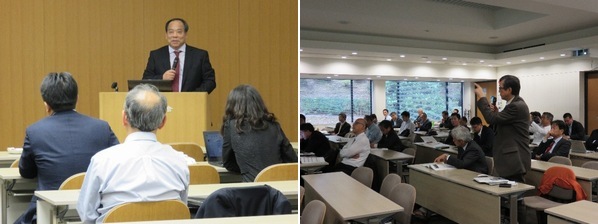
Photo 1: Scenes in keynote lectures
(Left) Keynote lecture by Prof. Yongsheng Li, (Right) Discussion by Prof. Tamon Ueda

Photo 2: All participants of the symposium
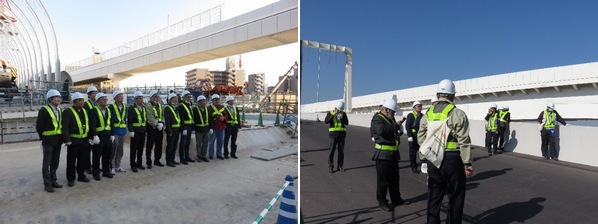
Photo 3: Technical visit to Namamugi Construction site
(Left) CCES participants attended site visit
(Right) Careful check on quality of project by Chinese participants
【Reported by Prof. Cho Ho (Nagoya Institute of Technology)】
Updates
- The summary of feature articles in the February 2017 issue of the JSCE Magazine is available on the JSCE website.
http://www.jsce-int.org/pub/magazine - Five projects introduced in the booklet “TRANSFER OF CIVIL ENGINEERING TECHNOLOGY IN SERVICE” issued at the time of the 100th year anniversary of JSCE can be viewed on the JSCE Website.
http://www.jsce.or.jp/e/archive - The Journal of JSCE is the collection of research papers which can be viewed on the JSCE website.
- https://www.jstage.jst.go.jp/browse/journalofjsce
- Disaster Fact Sheet
http://committees.jsce.or.jp/disaster/ - IAC Students and Alumni Network
http://www.jsce-int.org/IAC_network
IAC News Subscription
The IAC News is one of the communication tools to share information and ideas with the members. We would like to invite you, your friends and colleagues to join the communication and to subscribe the IAC News. Please register online: (http://www.jsce-int.org/node/150). We look forward to meeting you.
